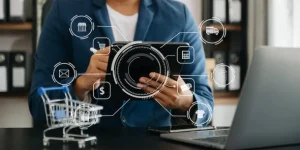Top 17 Latest Ecommerce Trends that Change How We Shop In 2025

The eCommerce industry is growing at tremendous speed. New eCommerce technology features and marketing strategies bring in new ways to make online purchases more accessible, enjoyable, and secure. Also, eCommerce innovations are taking the eCommerce industry one step ahead.
In this article, we have listed the latest eCommerce trends for your business, focusing on how digital transformation in eCommerce can help change the way people shop on your website or mobile app.
17 Latest eCommerce Trends
1. Augmented Reality
The introduction of augmented reality apps has changed the way users do online shopping by reducing uncertainty.
Due to AR, an online shopper has the freedom to check how a particular product looks before the shopper decides to purchase.
For instance, in clothing, a shopper can check how a particular cloth appears on them.
Moreover, for furniture, one can check how it looks in their home/office.
With AR, the product visualization process has become efficient.
From this, we can say that Augmented Reality can be useful to enhance the overall customer experience.
If you want to implement this kind of feature in your eCommerce store you can also approach an AR app development company.They will help you with a perfect solution for your store.
2. Contextual and Programmatic Advertising
Generally, programmatic advertising means to attract the correct audience at the correct time. By using programmatic advertising, an eCommerce business can apply a retargeting eCommerce strategy for a bigger audience.
The craze of integrating contextual and programmatic ads into the marketplaces is increasing every year. Moreover, some of the social media sites have begun changing their design as per this eCommerce trend.
Here, a particular dataset is decided to target a particular type of audience and then ads are displayed to the audience that is picked up as per the consumption. All these users are retargeted after a particular interval to get higher ROI.
3. Voice Search
People across the globe are slowly adopting intelligent virtual assistants like Alexa, Cortana, Siri, and others for shopping via voice search. Also, it has become one of the fastest growing eCommerce trends.
Moreover, voice search is essential for those users who use their mobile phones to access the store. It allows them the convenience of ordering something just through a voice command.
As per the latest Research by Google, voice search content must consist of a higher percentage of textual content. Hence, by implementing this, there are more chances that the content appears in snippets or knowledge graphs.
Moreover, leading eCommerce giants such as Amazon, North Face, etc. have begun making their eCommerce apps voice search centric.
Hence, if you own an online retail company and look to improve your website or app, you can also integrate the voice search feature into your eCommerce store by hiring an Alexa skill development company.
To ensure that your website/app becomes the best in the eCommerce industry, you must look at the user experience critically and in this effort, voice search will help you a lot.
4. Marketing Automation
Automation of various things in the eCommerce sector is reaching new heights every year. Due to this, it has become one of the latest eCommerce trends that businesses should implement in their stores.
Earlier it was considered that marketing automation consists of only two things, which include email marketing and planning for social media posts. But it has become advanced now & also includes things like tailor-made landing pages and simple yet effective shopping carts.
If marketing automation is done efficiently, you can do various things as follows:
- Send customized emails to your customers.
- Showcase the latest products and promotions based on the shopping history.
- Carry out retargeting for vital products
5. Blockchain Technology
Blockchain is a great way to find out about the origin of a product. This will help your company reduce the chances of any counterfeit goods in the stock, which will help your company maintain its goodwill in the market.
Blockchain technology can also help your customer find out the origin of an individual product used to make a food item (or, for that matter any other item).
By integrating blockchain technology, you can also help people to figure out which one of your products is fresh and is made up of good quality ingredients. This will help them make a more informed choice when buying any product. In short, it helps to increase transparency.
Apart from these, Blockchain technology will be highly beneficial to the eCommerce industry in many other ways. Such as enhancing supply chain tracking, providing new modes of payment, etc.
Want to Leverage the Power of Emerging eCommerce Trends?
We help you to incorporate the latest trends to your store. These trends
can skyrocket your conversion rates and drive customer loyalty.
6. Mobile Commerce
Mobile commerce, or m-commerce, is a rapidly growing trend in the world of e-commerce. With the widespread use of smartphones and tablets, consumers can now shop conveniently and securely from anywhere using their mobile devices.
People increasingly rely on their handheld devices for various shopping activities. From searching for products and comparing prices across different stores to accessing detailed descriptions, reviews, and testimonials, mobile devices have become essential tools for informed purchasing decisions.
Additionally, advancements in mobile technologies have significantly improved the reliability and security of mobile payments, making it safer and more convenient than ever to make purchases on the go.
To cater to the growing trend of mobile commerce, it is essential for all eCommerce websites to be mobile-friendly. This can be achieved through two approaches:
- Adaptive design: This involves creating a mobile version of the eCommerce website that is optimized for smaller smartphone screens. The design should feature simplified navigation, fewer buttons, and focus on providing key information about products.
- Mobile app development: Developing an eCommerce mobile app provides a separate software solution that users can download onto their mobile devices. Mobile apps offer enhanced functionalities and features, benefiting both customers and businesses.
Also Read: Top Mobile Commerce Trends to Consider
7. Subscriptions
Customers engage more with the subscription-based business and these services will continue to increase in upcoming years.
In case you don’t provide any products or items in the subscription model, this is the best time to categorize your products as per the subscription-based business.
It is one of the latest eCommerce trends that enables you to handle your inventory with ease and also offer better customization and personalization options to develop great relationships with your audience.
For example, Amazon launched a Prime subscription program a few years back in which it provides users with various benefits such as faster-delivery, exclusive shopping deals, etc.
Lastly, a subscription-based model allows you to generate a recurring and stable income to achieve your sales goals.
8. Localized and Personalized Shopping Experiences
Localization is mainly a type of personalization, which is also known as alteration of the website content. For this, identify the IP address of the customer and offer highly content-sensitive merchandising.
Personalization is known as personalized merchandising in eCommerce. A user is bombarded every day with a lot of emails, notifications, text messages, etc. Hence, to remain ahead of the competition, you should utilize a user’s data points to customize your website and offer specific products.
The data points consist of a user’s search history, purchase history, shopping cart, social behavior, geographic location, or segments. Using these data points, you can build specific and engaging personalized experiences for customers every time you interact with them.
9. Social Commerce
Out of various eCommerce new trends, having an online shop on social media is the fastest-growing trend.
Moreover, Facebook & Instagram have entered into the eCommerce sphere by launching their shops. Generally, it’s nothing but a streamlined version of the online eCommerce store.
One of the major advantages of Facebook and Instagram is that both apps are optimized for eCommerce stores. You only need to build a customized shop section as your Facebook page or the Instagram profile.
With the help of this shop, customers would be able to do various things like browse, save, purchase, and share. Currently, the facility is only available in fewer regions; however, it will soon be available worldwide.
You have the opportunity to attract a wider audience with the help of these shops. For this, you have to regularly create content that your customer loves in different formats like posts, banners, and ads.
Want to Implement eCommerce Trends to Unlock Success?
We help you to implement the latest trends that will ignite your sales
and propel your eCommerce business to new heights.
10. Visual Search
In today’s age, millennials love to search for products using visual search or image recognition features; due to this, many brands across the world started integrating this trend in their eCommerce stores.
As per rocketspace, a popular innovation agency, visual search will help eCommerce stores to generate 30% more revenue by 2022.
Taking in terms of content personalization, brands have an excellent opportunity to offer a better experience to the user by helping them to find products with ease.
11. Buy Now Pay Later
Buy Now Pay Later (BNPL) is a popular trend in the world of e-commerce. It offers consumers the flexibility to make purchases without upfront payment and instead allows them to pay in installments over a specific period. With BNPL services, customers can enjoy immediate access to products or services while spreading the cost over time.
This trend is gaining traction due to its convenience, affordability, and ability to attract a wider range of customers. However, it is important for consumers to use BNPL responsibly and be mindful of the repayment terms to avoid excessive debt.
12. Video Commerce
Building content in the format that consumers love to consume is highly essential; it doesn’t matter in which format people consume it.
Nowadays, people worldwide prefer to watch videos on YouTube and other platforms to check product reviews. This indicates that video for product reviews will help to enhance your sales.
Hence, if your eCommerce store hasn’t yet taken advantage of video, then 2022 is the best year to begin video commerce.
13. Headless and API Driven Commerce
The majority of customers don’t have any idea about the backend tech structure of their most loved eCommerce store, although it has a great impact on their experience.
Headless eCommerce is such a solution that enables the presentation layer of the eCommerce platform to be separate from the store’s eCommerce platform.
Using headless eCommerce, you can provide a highly personalized shopping experience and feature-rich content to your audience.
Generally, headless eCommerce relates to the utilization of eCommerce platforms that don’t need a ready-made storefront. Example: Shopify or Magento.
Here, data is fetched from the backend through API and is decoupled from the frontend. Here, you have the freedom to do anything with the storefront on different channels such as mobile, desktop, and social media.
For instance, you can utilize a content management system(CMS), Digital Experience Platform (DXP), Progressive Web App(PWA), or any custom frontend to complete your tech stack.
This can significantly impact what the store wants to achieve through SEO, content marketing, and digital experience.
Lastly, in the coming years, there will be a rise in the adoption of new headless frontend solutions such as IoT and PWAs. It will be adopted in a market over a massive scale by smaller businesses.
14. AI Chatbots
AI chatbots are one of the leading eCommerce trends that are being implemented by businesses over the last few years.
According to Mordor Intelligence, the worldwide chatbot market is anticipated to generate USD 20.81 Billion in revenue in 2029.
As per IBM, Chatbots could answer around 80% of the primary questions.
This indicates that chatbots will be one of the fastest-growing eCommerce trends in the next few years.
AI Chatbots enable online eCommerce businesses to interact with a wide number of users online, along with giving them personalized attention and best product suggestions as per their responses. You can contact a chatbot development company to implement an AI chatbot in your eCommerce store.
Also Read: Artificial Intelligence in eCommerce: Benefits and Use Cases
15. Drone Delivery
Drone delivery is one of the most popular trends in the eCommerce industry that is growing at an incredible speed. Over the last few years, there are a lot of things revolving around drone delivery technology.
Also, Amazon started testing drone delivery back in 2017.
After this, many other giants have also entered into this space, such as Uber, UPS, and Dominos. They have also started advanced drone delivery testing to offer this service to their customers.
In this technology, Google Maps are integrated with the drones, identifying the shortest route to the destination, and delivering the product to the desired customer.
This trend will advance more in the upcoming years. We will also observe drone delivery as becoming one of the most vital components of various eCommerce businesses.
Embrace the Latest eCommerce Trends for Your Store!
Unleash the full potential of your eCommerce store with the latest trends.
Stay ahead of the competition and captivate your customers in exciting ways.
16. Content Repurposing
Content Repurposing is the method of reusing and updating the entire elements of the already published content to enhance its content’s reach. For instance, if you published a blog post a while ago, you can make a video on the same and reach out to a new audience.
Content repurposing is relatively effective as compared to coming up with new content regularly.
17. Multi-Platform Journey with Platform-Specific Messaging
Omnipresence has become one of the important eCommerce technology trends. A Customer’s shopping journey is not straightforward, and hence businesses need to be available on different platforms.
Your customers would be shifting for information from Facebook, Instagram to mail to SMS, and so on & so forth. Therefore, it is highly essential to have a platform-specific bot on every platform.
The main purpose is to deliver the specific message to a specific person at the correct time by understanding how they want the information about a particular query.
For instance, a customer loves to get offers about top-rated products on mail and if an eCommerce store sends an SMS, then the customer will abandon it.
Therefore, you need to target customers through a specific platform only. For instance, for sending texts to users, you need to include an automatic SMS service tool.
By integrating multi-platform messaging, you have to offer customers what they desire and be with them to take the conversation to the next level.
Wrapping it Up
eCommerce is getting bigger every year and to make your mark in the industry for long; you need to take the help of the latest technological advancements.
By keeping in mind consumer behavior, you should choose the latest eCommerce trends that align well with your business and help you not only to improve the shopping experience of customers but also to build a long-lasting relationship with them.
Are you still wondering about which trends fit well with your eCommerce business? Then don’t hesitate to share your queries with us. Our experts will give you a perfect solution to your query free of cost.
We at Guru TechnoLabs, provide eCommerce development services. We possess professionals who will help you decide the best trends as per your business goals and requirements and also integrate them into your eCommerce store.
Frequently Asked Questions
Keeping up with eCommerce trends helps businesses stay competitive, improve customer experience, and adapt to changing market demands. It ensures you're using the latest strategies and technologies to grow and meet consumer expectations.
Small businesses can adapt to eCommerce trends by below steps, and using insights from an e-commerce business guide to refine strategies.
- Embracing Affordable Tools: Utilize cost-effective platforms for website building, email marketing, and social media.
- Personalizing Customer Experiences: Offer tailored product recommendations and services to boost customer satisfaction.
- Referring to an E-Commerce Business Guide: Use expert insights to shape strategies and stay updated on best practices.
- Adopting Sustainable Practices: Implement eco-friendly packaging or ethical sourcing to align with consumer values.
- Collaborating Strategically: Partner with influencers, local businesses, or marketplaces to expand reach.
- Staying Flexible: Be open to experimenting with new trends and adapting quickly to market changes.
Digital wallets, Buy Now Pay Later (BNPL), cryptocurrencies, contactless payments, and biometric options are leading the way. Offering these ensures a seamless checkout process, boosting customer satisfaction and sales.


















